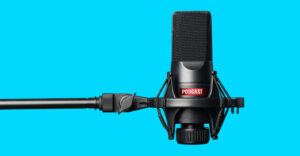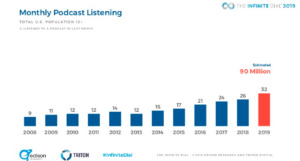A Pessimist’s Guide to Podcast Growth

Recently there’s been a lot of noise made about how podcasting is about to break into the big time. We’ve heard that before, of course, and have been hearing it for well over a decade, but now there are financial reasons to believe it might actually be true. Slate has announced it is expecting nearly half its revenue will come from its podcasts this year, after making significant investments in audio last year. It did so after reportedly seeing a significant uptick in overall advertising and membership revenue off the back of its podcasts, which is also one reason given by the NYT for their overall subscription success off the back of its podcasts including The Daily.
According to the latest Infinite Dial report from Edison, the average time per individual spent listening to podcasts has been steadily ticking up over the past few years, with 32 percent of the US population expected to have listened to a podcast monthly. Better still, research from Acast demonstrates that 76% of podcast listeners exposed to an ad took some form of follow-up action on the ad.
I really love this kind of charts. STRONG GROWTH OVER 5 YEARS (asterisk: 2nd to 5th year is a projection) #Podcasts #Studienmurks @FIPPWorld https://t.co/xigQk4gs0p pic.twitter.com/sOJD7eZabN
— pvdigest (@pvdigest) April 30, 2019
Consequently everyone and their dog has been casting a greedy eye at the expected exponential growth in advertising revenue, which is currently a tiny proportion of total audio adspend but predicted to become a large part of it over the next few years. Writing for The Drum, Emma Mulcahy explains:
“Revenues from programmatic audio ads in podcasts were in excess of $220m in 2017, which makes for a staggering 85% increase on the same figures from 2016.”
Along with my two co-hosts, I recently celebrated the 100th episode of our media-focused podcast Media Voices, managing to get the editors of Empire and The Week, in addition to guests from Pink News and Bibblio, to appear on a large panel with us. Though we’ll likely never make any significant advertising revenue from the podcast (we have started using it as a marketing vehicle for our reports), we have now been doing the podcast for close to three years. In that time we have seen any number of predictions of the next big ‘boom’ for podcasting, but we’ve also learned to be realistic about the growth of the podcast as a medium.
Even though I love the medium dearly, here are some reasons to be pessimistic about the growth of podcasts for publishers:
As we’ve written about before, traditional podcast advertising has some real advantages over other ads. For the most part those ads are in-stream and read by the host in a manner that is extremely similar to the content as a whole. Consequently, the stat referred to earlier that 76% of listeners follow-up on an ad is predicated on the idea that podcast ads are more effective than other audio and video ads which consumers have become blind to.
However most podcast ad metrics are still relatively blunt. Because podcast ad-tech was basically non-existent for the first decade of its existence, the use of discount codes to be entered on an advertisers’ site was the dominant form of proving ROI to an advertiser. There are new means of inserting ads into podcasts that don’t necessarily rely on codes, but for the most part proving ROI for podcast advertising is still in its infancy.
More importantly, in order to attract new advertisers into the podcasting market, it isn’t enough simply to prove the success of an individual podcast in selling a product, or even demonstrating the success of a larger podcast network like Slate’s.

The cost of entry for new podcasts is very small. You can launch and publish a decent-sounding podcast on your own using just a laptop. In that way the first decade of user-produced podcasts are very similar to the early days of blogging, when legitimate businesses were born out of fan and niche blogs that managed to carve a space out of early internet publishing.
However, most podcasts peter out by the seventh episode, a phenomenon that has been termed ‘podfade’. There are any number of reasons why that might be the case, but an inability to find an audience in an ever busier space is certainly a factor. As larger media companies with the resources to promote and stick with a podcast strategy enter the market, there is the potential to crowd out discovery and revenue for independent publishers. While publishers are avoiding the ‘mistake’ they made by allowing weblogs to gain a foothold and steal away audiences, it might come at the cost of diversity of podcast creators.
It’s still early days for the podcast industry, and any number of developments could help accelerate that predicted adspend still further. But there are potential impediments, and if we want to avoid any disappointment about the extent to which podcasts can contribute to media companies’ bottom lines, we need to address them and manage expectations.
Chris Sutcliffe
enquiries@trippassociates.co.uk
Martin Tripp Associates is a London-based executive search consultancy. While we are best-known for our work across the media, information, technology, communications and entertainment sectors, we have also worked with some of the world’s biggest brands on challenging senior positions. Feel free to contact us to discuss any of the issues raised in this blog.